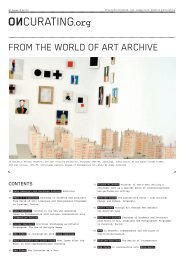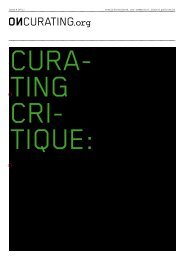Create successful ePaper yourself
Turn your PDF publications into a flip-book with our unique Google optimized e-Paper software.
038 Issue # 11/11 : PublIc Issues<br />
Usages and appropriations in Tokyo<br />
Life on the streets of Tokyo is less versatile than it<br />
is in Shanghai, even on the very small streets, the roji.<br />
At the beginning of the 20th century, some intellectuals<br />
liked to stroll through the small streets of Tokyo's old<br />
town. Following Walter Benjamin, some writers turned<br />
strolling into literary content and a lifestyle (Schulz<br />
2008). But not much of this remains in the 21st century.<br />
Strolling in the city, rather, seems to correspond to<br />
a European idea. Nowadays, Tokyo residents move through<br />
the city very purposefully, whether they cover great<br />
distances using the extremely efficient public transport<br />
system, or whether they only move within their quarter,<br />
in which most of the distances can be covered comfortably<br />
on foot or by bicycle. Tokyo is a paradise for cyclists.<br />
You can ride everywhere and in both directions, even on<br />
the pavements (fig. 17). In addition, bikes are very cheap<br />
and are seldom stolen.<br />
Tokyo's public space is appropriated much less intensively<br />
by residents than in Shanghai. A typical appropriation<br />
which is quite refined (and therefore accepted by the muni-<br />
cipal authorities) appropriation in Tokyo are so-called<br />
pot gardens, which stand in front of the houses on the pave-<br />
ment and sometimes on the street (fig. 20). Thus, in an<br />
unobtrusive way the residents of the buildings extend their<br />
interior space to the exterior space, thus transforming<br />
the roji almost unnoticeably from an open area to an inner<br />
area.<br />
The street <strong>as</strong> t<strong>as</strong>k<br />
This investigation of urban spaces in Tokyo and Shanghai<br />
shows that the Western way of dividing space into private<br />
and public are<strong>as</strong> cannot be transferred to Chinese and<br />
Japanese cities. The different sense of space – or better,<br />
the different production of space – in China and Japan<br />
h<strong>as</strong> given rise in the course of the centuries to specific<br />
kinds of building, which cannot be meaningfully gr<strong>as</strong>ped<br />
by the private/public dichotomy. A lilong quarter in Shang-<br />
hai or a roji in Tokyo are both designs that give this<br />
different constitution of space a visible form. The inter-<br />
play between spatial perception, spatial conception and<br />
material space design h<strong>as</strong> yielded an attractive living<br />
space where people have felt comfortable for generations.<br />
There is the danger that these spaces will disappear if<br />
municipal authorities and multinational investors do not<br />
respect the specific sense of space of their own culture<br />
and prefer architectures and m<strong>as</strong>ter plans from the West.<br />
The street in particular – and this applies to both E<strong>as</strong>t<br />
Asian and Central European cities – plays a role for<br />
preserving active living spaces that should not be underestimated,<br />
which is why the architect Kisho Kurokawa,<br />
for one, h<strong>as</strong> repeatedly pleaded (and I would like to close<br />
by joining him in this plea) that the street should be<br />
taken seriously <strong>as</strong> an urban development t<strong>as</strong>k (see note 5).<br />
Reference list<br />
ETH Zurich, Swiss<br />
Federal Institute<br />
of Technology<br />
(ed.), Faculty of<br />
Architecture,<br />
Professor Günther<br />
Vogt. See also:<br />
http://www.<br />
taking-to-thestreets.com.<br />
Haarmann, Anke.<br />
"Public Blue: Eine<br />
Besetzung des öf-<br />
fentlichen Raums",<br />
In: Archiv von<br />
The Thing Hamburg:<br />
Plattform für<br />
Kunst und Kritik<br />
(30 March 2007):<br />
http://www.thing-<br />
hamburg.de/index.<br />
php?id=499<br />
(accessed 08 March<br />
2011).<br />
Kurokawa, Kisho<br />
(2005). D<strong>as</strong><br />
Kurokawa-Manifest,<br />
Jovis, Berlin.<br />
Krusche, Jürgen<br />
and Frank Roost<br />
(2010). Tokyo: Die<br />
str<strong>as</strong>se als ge-<br />
lebter Raum. Lars<br />
Müller Publishers,<br />
Baden.<br />
Krusche, Jürgen<br />
(2011). str<strong>as</strong>senräume<br />
in berlin,<br />
shanghai, Tokyo,<br />
Zürich: eine<br />
fotoethnografische<br />
untersuchung. Lars<br />
Müller Publishers,<br />
Baden.<br />
Lefebvre, Henri<br />
(1974). la<br />
production de<br />
l'espace. Éditions<br />
Anthropos, Paris.<br />
(published in<br />
English <strong>as</strong> The<br />
Production of<br />
space. Blackwell,<br />
Oxford, 1991).<br />
Münch, Barbara.<br />
"Verborgene Kon-<br />
tinuitäten des<br />
chinesischen<br />
Urbanismus". In:<br />
Archplus,<br />
chinesischer<br />
Hochgeschwindigkeitsurbanismus,<br />
Vol. 168,<br />
1/2004.<br />
Schoon, Sonia.<br />
"Umfriedung und<br />
Draussen in der<br />
dichotomen Lebens-<br />
welt Shanghai."<br />
In: Jürgen H<strong>as</strong>se<br />
(ed.) (2008).<br />
Die stadt als<br />
Wohnraum, Alber,<br />
Munich.<br />
Schulz, Evelyn.<br />
"Die 'Renaissance<br />
der Stadt' (toshi<br />
saisei) und die<br />
Wiederentdeckung<br />
der Hinterg<strong>as</strong>sen<br />
(roji) – Aspekte<br />
der Literatur und<br />
Kultur des<br />
Flanierens." In:<br />
Jürgen Krusche<br />
(ed.) (2008). Der<br />
Raum der stadt.<br />
Jon<strong>as</strong>, Marburg.<br />
Soja, Edward<br />
(1996). Third<br />
space. Blackwell,<br />
Cambridge.<br />
Zhang, Guanzeng.<br />
"Struktur und<br />
Wandel des öffent-<br />
lichen Raums in<br />
Shanghai." In: Die<br />
aufgeschlossene<br />
stadt: Öffentlicher<br />
stadtraum<br />
in china von<br />
Anting bis Zhuhai,<br />
Dieter H<strong>as</strong>senpflug<br />
(ed.) (2004). VDG,<br />
Weimar.


![Download as PDF [10.6 MB]](https://img.yumpu.com/4266533/38/500x640/download-as-pdf-106-mb.jpg)

